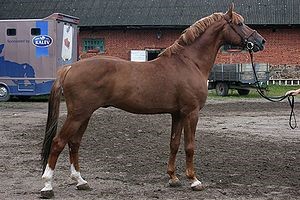 |
|
Tori, or Tori Hobune, horses were developed at the Tori stud
in Estonia from 1890 to 1950. They were developed by crossing native Estonian
mares with European half bred stallions. They were mainly founded by a stallion
named Hetman, whose sire was Stewart, a crossbreed of a Norfolk Trotter and an
Anglo-Norman mare. The Tori breed was formed by breeding Hetman and his sons.
Thus, a valuable breeding nucleus rapidly formed, that slowed as signs of
inbreeding depression were found in the 1930's. This deteriorated performance
and robustness. To eliminate this inbreeding depression, Toris were crossed
with Breton Post-horse stallions, and as a result, the massive type of Tori
became widespread while the quality of the gaits declined. The need for a
combination of utility and sporting qualities in horse led to crossings with
Hanoverian and Trakehner stallions. Recent horse breeders have been trying
mainly to get a very light sport horse-type of horse, resulting in a rapid loss
of purebred Tori. There are fewer than 100 purebreds and only three purebred
studs remaining.
Tori horses are found mainly in the black, bay, palomino,
chestnut, and liver chestnut. Today's Tori is a harness horse that has a clean
and solid build. They have a large to medium-sized head, a shortened poll, a
neck that is medium in length and fleshy, withers that are average in height, a
back that is long and flat, a loin that is broad as well as a croup that is
broad, and they are well muscled. They have a very broad and deep chest, and their
limbs that are clean and properly set. Tori stallions are usually 162 cm or 16
hand high at the withers. The mares have high fertility ratio, with 86 foals
per 100 mares.
